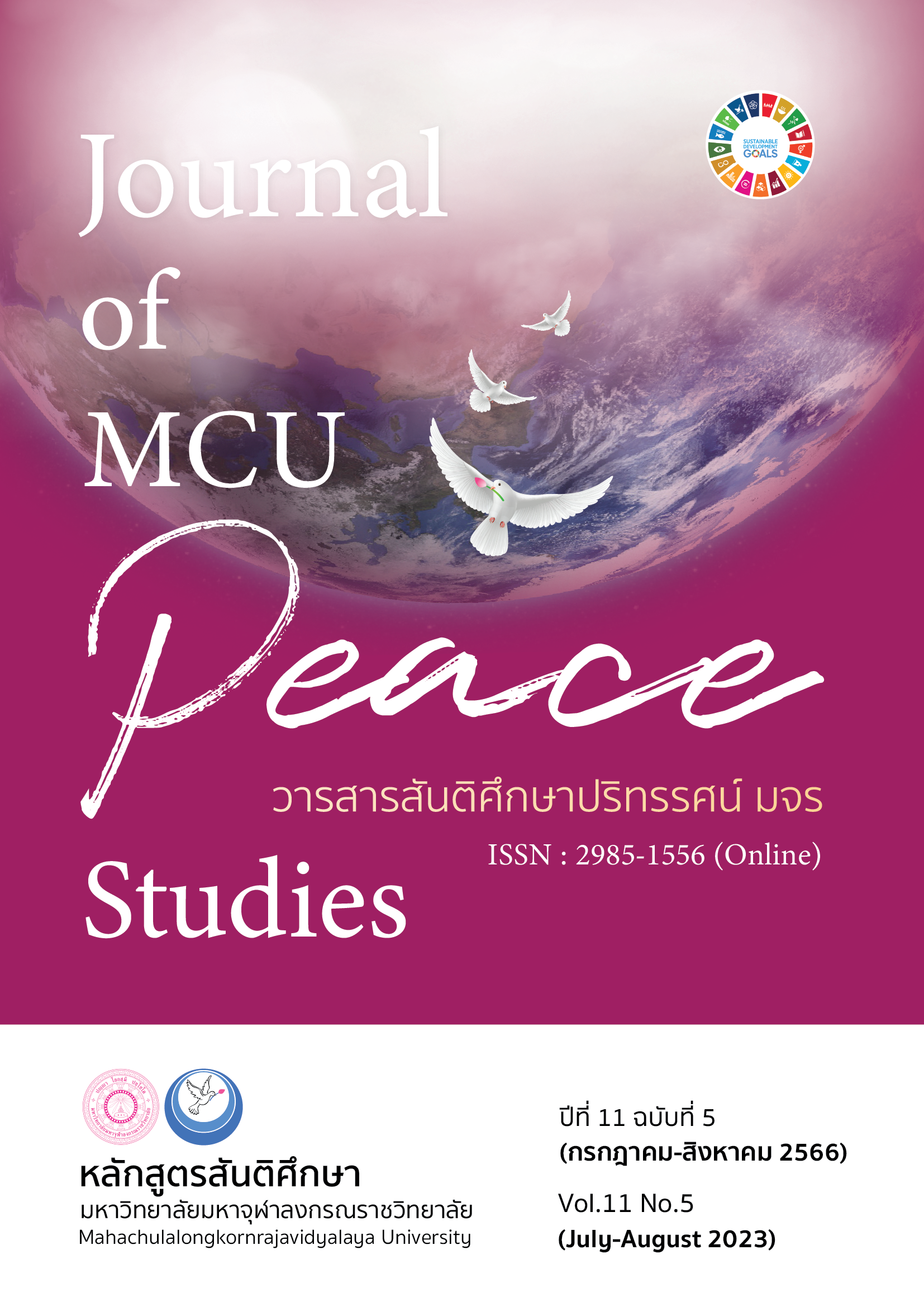หลักธรรมกับการไกล่เกลี่ยในคดีอาญา
Main Article Content
บทคัดย่อ
บทความวิชาการนี้ มีวัตถุประสงค์เพื่อสะท้อนหลักธรรมที่เอื้อต่อการไกล่เกลี่ยคดีอาญาในศาลอุทธรณ์ โดยศึกษาจากคัมภีร์ทางพระพุทธศาสนา เอกสาร งานวิจัยและมุมมองของนักวิชาการทางพระพุทธศาสนาที่เกี่ยวข้องกับหลักการแนวคิดทฤษฎี และกระบวนการ วิธีการ ของการทำหน้าที่เป็นผู้ไกล่เกลี่ย เสมือนเป็นโค้ช ให้ข้อคิด ทางออกของคู่ความ ผู้กระทำความผิด และการบรรเทาความเสียหายหรือความทุกข์ของผู้เสียหาย รวมถึงครอบครัวผู้เกี่ยวข้อง เพื่อนำเสนอให้เห็นแนวทาง วิถีปฏิบัติที่เป็น อัตลักษณ์ และสอดคล้องกับหลักธรรม ที่เอื้อต่อการไกล่เกลี่ยในคดีอาญาโดยนำหลักของอริยสัจ4 เป็นกรอบกระบวนการไกล่เกลี่ยซึ่งในปัจจุบันนี้หลักการแนวคิดกระบวนการไกล่เกลี่ยถูกนำมาใช้ในศาลยุติธรรมไทยทั้งศาลชั้นต้น และศาลชั้นอุทธรณ์ โดยอาศัยผู้ประนีประนอมทำหน้าที่เป็นคนกลางไกล่เกลี่ย ซึ่งผู้ประนีประนอม ที่ได้รับการคัดเลือกเข้ามาช่วยงานศาลยุติธรรม เป็นผู้ทำหน้าที่คอยช่วยเหลือ ในการไกล่เกลี่ยประนีประนอมยอมความคู่ขัดแย้งมีสิทธิเสรีภาพในการตัดสินใจ หากตกลงกันได้ จะทำให้คู่ความประหยัดค่าใช้จ่าย ประหยัดเวลาลดปริมาณคดีในศาล และยังอาจรักษาความสัมพันธ์ของคู่กรณีไว้ได้ บทบาทหน้าที่ผู้ไกล่เกลี่ยไม่มีอำนาจชี้ขาดบังคับ ผู้ทำหน้าที่ไกล่เกลี่ยต้องมีความเป็นกลาง มีทัศนคติเชิงบวก มีพฤติกรรมน่าเคารพเชื่อถือ รักษาความลับ เป็นต้น ในมุมมองพระพุทธศาสนาการทำหน้าที่เป็นผู้ไกล่เกลี่ยต้องมุ่งให้คู่ขัดแย้งรู้จักควบคุมอารมณ์ ลดละอกุศลมูลให้เบาบางลง กระตุ้นสร้างให้เกิดการฉุกคิดด้วยเหตุด้วยผล การจะกระทำได้ดังกล่าว ต้องมีองค์ประกอบหลักธรรม คือ การมีสติตื่นรู้ การใคร่ครวญ ระมัดระวัง สุขุม และ มีจิตเมตตา, อันเป็นองค์ประกอบของหลักไตรสิกขาซึ่งเป็นหลักธรรมสำคัญที่ใช้เป็นข้อปฏิบัติ อบรมจิต เพื่อกำจัดกิเลสมนุษย์เป็นกระบวนการ ในการจัดตั้งระเบียบแบบแผนเกี่ยวกับการดำเนินชีวิตการอยู่ร่วมกันของมนุษย์ คือ ศีล, สมาธิ, ปัญญา ด้วยหลัก 3 ประการ: นำปฏิบัติ, พัฒนาจิต, พิชิตทางสว่าง, จะสามารถเกิดการเชื่อมโยงสู่การปฏิบัติได้อย่างมีประสิทธิภาพ เมื่อเอาธรรมไปทำหรือปฏิบัติ ย่อมเกิดบทบาทการทำหน้าที่ ในแนวทางการไกล่เกลี่ยคดีอาญา ตามหลักพุทธสันติวิธี ที่มีความสมบูรณ์ และ มีประสิทธิภาพรอบด้าน การนำหลักธรรมมาใช้ไกล่เกลี่ย จึงเป็นองค์ประกอบสำคัญที่เหมาะสมในการไกล่เกลี่ยคดีอาญาในศาลอุทธรณ์
Article Details

This work is licensed under a Creative Commons Attribution-NonCommercial-NoDerivatives 4.0 International License.
ทัศนะและความคิดเห็นที่ปรากฏในบทความในวารสาร ถือเป็นความรับผิดชอบของผู้เขียนบทความนั้น และไม่ถือเป็นทัศนะและความรับผิดชอบของกองบรรณาธิการ ยินยอมว่าบทความเป็นลิขสิทธิ์ของวารสาร
References
Buddhadasa Bhikkhu. (1991). Life Solution. Bangkok: Sangdhram Publishing.
Court of Justice. (2019). Regulations of the Executive Committee of the Court of Justice on Conciliation of Criminal Disputes B.E. 2560. Retrieved January 15, 2023, from https://library.coj.go.th/ebook.html?bid=49583&fid=48638#page/2
Kittayarak, K. (2020). Justice Next Challenges: New Challenges for the Thai Justice System. Retrieved January 15, 2023, from https://www.the101.world/kittipong-kittayarak-one-on-one/
Limprangsi, S. (2009). Restorative Mediation in Criminal Case. (2nd ed.). Bangkok: Thana Press Co., Ltd.
National Strategy 2018-2037. (2018). Royal Thai Government Gazette V 135 (82) a, October 13, 2018.
Office of the Judiciary Executive Committee. (2019). Regulations of the Executive Committee of the Court of Justice on Conciliation of Criminal Disputes B.E. 2560. Retrieved January 15, 2023, from https://library.coj.go.th/ebook.html?bid=49583&fid=48638
Phra Brahmagunabhorn (P.A. Payutto). (2001). Buddhadharma Original Edition. (11th ed.). Bangkok: Saha Dhammak Printing Co., Ltd.
______. (2013). Dictionary of Buddhism. Bangkok: Pali Dhamma Publishing Company.
______. (2016). Dictionary of Buddhism. Bangkok: Pali Dhamma Publishing Company.
Phuriwikrai, K. (2020). Sustainable Dispute Resolution Through Restorative Justice. Retrieved January 15, 2023, from https://www.the101.world/handbook-on-restorative-justice/
Recommendations of the President of the Supreme Court on Guidelines for the Treatment of Victims in Criminal Cases B.E. 2563. (2020). Royal Thai Government Gazette V 137 (92) a, November 6, 2020.
Requirements of the President of the Supreme Court on Mediation (No. 2), B.E. 2560. (2017). Royal Thai Government Gazette V 134 (68) a, June 30, 2017.
Royal Institute. (2013). Royal Institute Dictionary. Bangkok: Sirivatana Interprint Public Company Limited.
Sutanun, S. (2016). Religious Principles and Mediation: A Solution to the Problem. (2nd ed.). Bangkok: Dispute Settlement Office Court of Justice.
Thanyasiri, P. (2021). Knowledge and Understanding of People on the Role of Community Justice Center to Strengthen Reconciliation and Peaceful Culture for Provincial Justice Offices’ Pilot, the Ministry of Justice. Retrieved January 15, 2023, from https://so03.tci-thaijo.org/index.php/papojournal/article/view/253562/171657
The Court of Justice of Thailand. (2021). Strategic Plan of the Court of Justice B.E. 2018 -2021. Bangkok: Office of the Judiciary.
______. (2022). Strategic Plan of the Court of Justice B.E. 2022 -2025. Bangkok: Office of the Judiciary.
Uthaithani Provincial Court. (2019). Regulations of the Office of the Court of Justice on Dispute Mediation According to Dispute Mediation Act B.E. 2562. Retrieved January 15, 2023, from https://uttc.coj.go.th/th/content/category/detail/id/9875/cid/9876/iid/178828
Yuprasert, P. (2011). Techniques, Psychology and Communication for Mediation. Bangkok: Dispute Settlement Office Court of Justice.

